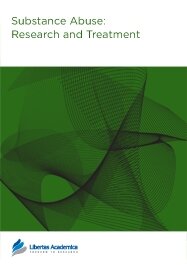

Publication Date: 16 Nov 2010
Type: Original Research
Journal: Substance Abuse: Research and Treatment
Citation: Substance Abuse: Research and Treatment 2010:4 61-66
doi: 10.4137/SART.S6211

The present study was conducted to investigate the effect of potassium channel openers and blockers on morphine with-drawal syndrome. Mice were rendered dependent on morphine by subcutaneous injection of morphine; four hours later, withdrawal was induced by using an opioid antagonist, naloxone. Mice were observed for 30 minutes for the withdrawal signs ie, the characteristic jumping, hyperactivity, urination and diarrhea. ATP-dependent potassium (K+ATP) channel modulators were injected intraperitoneally (i.p.) 30 minutes before the naloxone. It was found that a K+ATP channel opener, minoxidil (12.5–50 mg/kg i.p.), suppressed the morphine withdrawal significantly. On the other hand, the K+ATP channel blocker glibenclamide (12.5–50 mg/kg i.p.) caused a significant facilitation of the withdrawal. Glibenclamide was also found to abolish the minoxidil’s inhibitory effect on morphine withdrawal. The study concludes that K+ATP channels play an important role in the genesis of morphine withdrawal and K+ATP channel openers could be useful in the management of opioid withdrawal. As morphine opens K+ATP channels in neurons, the channel openers possibly act by mimicking the effects of morphine on neuronal K+ currents.
PDF (516.85 KB PDF FORMAT)
RIS citation (ENDNOTE, REFERENCE MANAGER, PROCITE, REFWORKS)
BibTex citation (BIBDESK, LATEX)
XML
PMC HTML

Each promise from the team at Substance Abuse: Research and Treatment has been backed up by action. Well organized team, prompt cycle times throughout the process of article submission, review, acceptance and article proofs. You guys have been fantastic. No wonder you've garnered such a good reputation in such a short time.

All authors are surveyed after their articles are published. Authors are asked to rate their experience in a variety of areas, and their responses help us to monitor our performance. Presented here are their responses in some key areas. No 'poor' or 'very poor' responses were received; these are represented in the 'other' category.See Our Results
Copyright © 2013 Libertas Academica Ltd (except open access articles and accompanying metadata and supplementary files.)
Facebook Google+ Twitter
Pinterest Tumblr YouTube